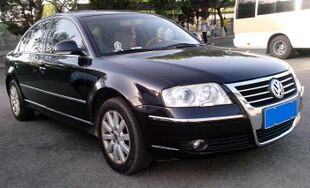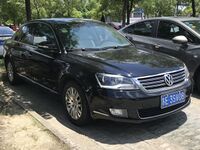Engineering:Volkswagen Passat Lingyu
| Volkswagen Passat Lingyu | |
|---|---|
 Volkswagen Passat Lingyu | |
| Overview | |
| Manufacturer | Volkswagen |
| Production | 2005–2011 |
| Assembly | China: Nanjing (2008–2009); Anting SAIC-VW) |
| Designer | Murat Günak |
| Body and chassis | |
| Class | Mid-size car (D) |
| Body style | 4-door sedan |
| Layout | Longitudinal Front engine, front-wheel drive |
| Platform | Volkswagen Group B5 platform |
| Related | Škoda Superb (3U) Volkswagen Passat (B5) |
| Powertrain | |
| Engine | 1.8 L EA113 I4 (turbo petrol) 2.0 L EA113 I4 (petrol) 2.8 L BBG V6 (petrol) |
| Transmission | 5-speed manual 5-speed automatic 4-speed automatic |
| Dimensions | |
| Wheelbase | 2,803 mm (110.4 in) |
| Length | 4,789 mm (188.5 in) |
| Width | 1,765 mm (69.5 in) |
| Height | 1,470 mm (57.9 in) |
| |uk|Kerb|Curb}} weight | 1,426 kg (3,144 lb) to 1,580 kg (3,483 lb) |
| Chronology | |
| Predecessor | Volkswagen Passat Classic V |
| Successor | Volkswagen Passat (NMS) |
The Volkswagen Passat Lingyu is a Chinese mid-size car produced by Volkswagen with its joint venture Shanghai Volkswagen plants in Anting and Nanjing.[1]
Overview
The Passat Lingyu was launched in November 2005 and replaced the Volkswagen Passat (B5) sold internationally. It is based on the same platform as the Škoda Superb I with more luxurious trim levels. In 2009, it was replaced by a facelift variant called the Volkswagen Passat New Lingyu.
The Passat Lingyu was offered in following equipment lines: Standard (标准型), Luxury (豪华型), VIP and Flagship (旗舰型). The Standard had a four-cylinder engine with a displacement of 1984 cc and a power of 85 kW. The Luxury and the VIP were delivered with a turbo engine with a displacement of 1781 cc and a power of 110 kW. The Flagship was the top model of the Lingyu lineup. It was motorized with a V6 engine with a displacement of 2771 cc and a power of 140 kW.
The car was designed by Istanbul-born car designer Murat Günak.[2]
Volkswagen built 20 examples of fuel-cell Passat Lingyu in mid-2008 to be presented at the 2008 Beijing Olympics.[3]
Facelift
A facelifted version was launched in 2009 and replaced the Volkswagen Passat Lingyu.[4][5] The Passat New Lingyu was offered in following equipment lines: Zenjie, Zenping, Zenxiang, Zhizen and Zenshi.
The following engines were offered: 1984 cc (85 kW); 1781 cc (110 kW); 2771 cc (140 kW).
The Passat New Lingyu was replaced by the Volkswagen Passat NMS in April 2011.
References
- ↑ Dixon, R. K., Wang, X., Wang, M. Q., Wang, J., & Zhang, Z. (2011). Development and demonstration of fuel cell vehicles and supporting infrastructure in China. Mitigation and Adaptation Strategies for Global Change, 16(7), 775-789.
- ↑ "2007 Volkswagen Passat Lingyu 2.0 Automatic specifications". https://www.carfolio.com/volkswagen-passat-lingyu-2.0-automatic-177452?car=177452.
- ↑ "VW Passat Lingyu FCV" (in en-US). https://www.hydrogencarsnow.com/index.php/vw-passat-lingyu-fcv/.
- ↑ "VW Passat Lingyu Unveiled at Auto Shanghai" (in en). https://www.motor1.com/news/15134/vw-passat-lingyu-unveiled-at-auto-shanghai/.
- ↑ "Chinese VW Passat launched" (in en). https://www.autocar.co.uk/car-news/new-cars/chinese-vw-passat-launched.
External links
- O fficial website (Lingyu)
- O fficial website (New Lingyu)
Template:Volkswagen (China) timeline 1984 to date
 |





